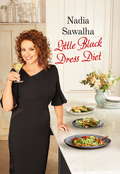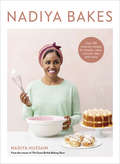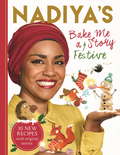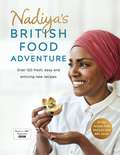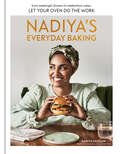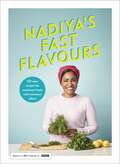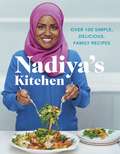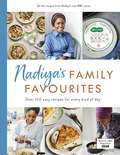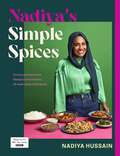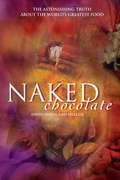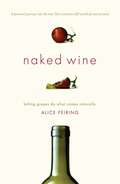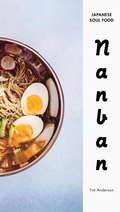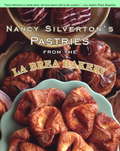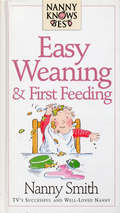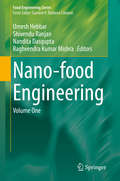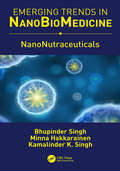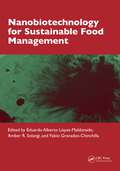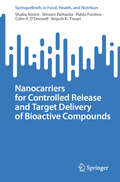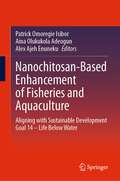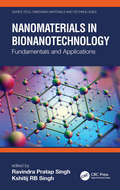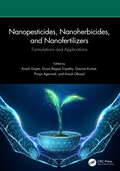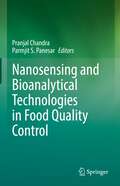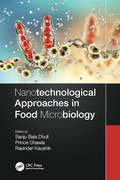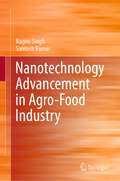- Table View
- List View
Nadia Sawalha's Little Black Dress Diet
by Nadia SawalhaNadia's Little Black Dress Diet, covering 100 recipes from Breakfast through to Dinner - not forgetting those scrumptious puddings - shows you how to make healthy yet succulent dishes to help you slip into your little black number. From quick and tasty recipes for thinner dinners and sinless snacks, Nadia gives her top tips on how to lose the weight - tricks to 'beat the bloat' and survival tips for the party season. And once you're there, Nadia reveals how to look your finest on the day, from which shoes to wear to the correct posture to adopt, everything you need to complement the new you. This is an essential book for anyone wishing to look and feel fabulous in their LBD.
Nadiya Bakes: Over 100 Must-Try Recipes for Breads, Cakes, Biscuits, Pies, and More: A Baking Book
by Nadiya HussainThe host of the beloved Netflix series Time to Eat and Nadiya Bakes and winner of The Great British Baking Show returns to her true love, baking, with more than 100 delicious, Americanized recipes for sweet treats.When Nadiya Hussain, the UK's "national treasure," began cooking, she headed straight to the oven--which, in her home, wasn't used for baking, but rather for storing frying pans! One day, her new husband asked her to bake him a cake and then... she was hooked! Baking soon became a part of her daily life. In her newest cookbook, based on her Netflix show and BBC series Nadiya Bakes, Nadiya shares more than 100 simple and achievable recipes for cakes, cookies, breads, tarts, and puddings that will become staples in your home. From Raspberry Amaretti Biscuits and Key Lime Cupcakes to Cheat's Sourdough and Spiced Squash Strudel, Nadiya has created an ultimate baking resource for just about every baked good that will entice beginner bakers and experienced pastry makers alike.
Nadiya's Bake Me a Festive Story: Thirty festive recipes and stories for children
by Nadiya HussainJoin Great British Bake Off sensation Nadiya Hussain for scrumptious stories and delicious bakes that the family can enjoy together at Christmas.Christmas is a time when families come together. This unique combination of storybook and cookbook, with all recipes and stories devised and written by Nadiya herself, brings families into the kitchen to share this special time of year through cooking and stories.- Go on an adventure to the Snow Queen's palace, then make her treacle icecream- Make and decorate cheesy-feet biscuits, then read the story about where all the odd socks go at Christmas time- Meet some very confused elves in The Elves and the Chouxmaker, then bake your own lemon choux buns- Read Nadiya's version of 'Twas The Night Before Christmas, then cook a scrumptious nut roastCombining playful photography of Nadiya and her children with vibrant illustrations by Clair Rossiter, this glorious celebration of the joy of sharing food and stories is the perfect Christmas gift.
Nadiya's British Food Adventure: Beautiful British recipes with a twist, from the Bake Off winner & bestselling author of Time to Eat
by Nadiya Hussain'National treasure' IndependentLet Nadiya take you on a culinary journey across Britain and discover over 120 fresh, simple and delicious recipes INCLUDES ALL THE RECIPES AND MORE FROM THE HIT BBC2 COOKERY SERIES____________Inspired by her journey around the country to discover the best In British food, Nadiya has created over 120 easy and enticing new recipes that mix local ingredients with her very favourite flavours, not forgetting a nod to her Bangladeshi roots. Whip-up classic British dishes with a twist such as: · Cayenne eggs benedict, soft poached eggs on an English muffin with smoked turkey rashers and cayenne hollandaise sauce. · A quick and easy grilled aubergine and feta tart on flaky, buttery puff pastry. · A West Indian tropical hit of fruity, fragrant pink peppercorn pineapple jam to top sweet scones and coconut cream. The ultimate exotic treat. Her reinvented classics capture the diversity of twenty-first century Britain - of tastes and culinary influences that shape what we love to cook and eat today.Nadiya's must-try recipes have got you covered from breakfast through to supper, whether you need fast mid-week meals, lunch on the go, something a little bit special, or gorgeous pudding or party ideas. Motivated by her love of family and food, flavour and fun, this is Nadiya cooking in the way she knows best - inspiring the rest of us to do the same.__________'The best kind of cookbook . . . you can read it like a novel' The Times'She baked her way into our hearts and hasn't stopped since' Prima
Nadiya's Everyday Baking: From Weeknight Dinners to Celebration Cakes, Let Your Oven Do the Work
by Nadiya HussainThe beloved Netflix host and New York Times bestselling author of Nadiya Bakes and Time to Eat presents more than ninety sweet and savory recipes for every meal, occasion, or mood. Nadiya Hussain, winner of The Great British Baking Show, knows that what we bake depends on the day of the week and what mood we&’re in. In Nadiya&’s Everyday Baking, Nadiya shares nearly 100 simple and achievable recipes for breakfast, dinner, dessert, and everything in between. Organized by situation and occasion, Nadiya&’s recipes are designed to always provide for a delicious, rewarding meal no matter what kind of day you&’re having:• Everyday Kind of Days when you&’re short on time: Harissa Pita Pockets, Sweet Potato Jalapeño Gratin, Crispy Tofu Lettuce Wraps• Chill Out Days when you want to move and cook slowly: Spring Onion Pancakes, Tandoori Chicken Naan Sando, Spicy Smashed Chickpeas• Rainbow Days when you need some color in your diet: Spinach and Paneer-Stuffed Shells, Crunchy Okra Fries, Fruity Baked Ricotta Dip• Happy Days when you want to cook something uplifting and celebratory: Paprika Egg Phyllo Tart, Mushroom Carnitas, Chocolate Hazelnut Cookie Pie • Baking Days with simple desserts for beginner bakers as well as elevated bakes for experienced ones: Cake in a Jar, Hot Chocolate Custard Pudding, Indian Gulab Jamun Cheesecake This stunning collection of recipes, alongside delightful photography and Nadiya&’s warm, inspirational voice, is sure to become a new favorite for home cooks and bakers alike.
Nadiya's Fast Flavours
by Nadiya HussainDiscover mouth-watering, time-saving new recipes to whip up this summer in Nadiya's latest bestselling cookbook'An abundance of refreshingly original ideas. Her recipes are achievable for us all' DAILY EXPRESS________Nadiya's Fast Flavours will bring the excitement back into your daily meals, with all the recipes she cooks on her hit BBC2 programme and more besides.Known for her bold and surprising flavour combinations, Nadiya loves to throw the rulebook out of the window, and is always adding her signature twist to classic recipes. Now she makes it easy for you to do the same, with a host of everyday recipes that are guaranteed to send your taste buds into overdrive, including . . .· Brioche Custard French Toast· Sweet-And- Sour Prawns with Noodles· Squash, Saffron And Grapefruit Soup· Blueberry And Fennel Ice Cream Cake· Lemon Leg Of Lamb with Jewelled Couscous· Coffee-Glazed FocacciaSour, sweet, spicy, zesty, earthy, fruity, herbal - her delicious recipes offer new and innovative ways to pack your meals with flavour, using clever shortcuts, hacks and handy ingredients to put the va-va-voom into your food but without spending hours in the kitchen.________Praise for Nadiya Hussain:'Let Nadiya fill your kitchen with pure joy' Woman & Home'All hail the brilliant Nadiya Hussain' Radio Times 'The queen of Bake Off' Good Housekeeping
Nadiya's Kitchen: Over 100 simple, delicious, family recipes from the Bake Off winner and bestselling author of Time to Eat
by Nadiya Hussain'National treasure' Independent Nadiya's first cookbook is filled with all of her favourite recipes for you to enjoy at home - from breakfasts to dinners to a cake fit for the Queen . . . Having fallen in love with Nadiya and her outstanding bakes on 2015's Great British Bake Off, readers can now discover all her favourite recipes. With chapters ranging from 'Lazy Sunday Mornings' to 'Midnight Feasts', 'Snacks and Sharing' to 'Dessert for Dinner', you'll find ideas for any time of the day, and for all the family. Nadiya offers innovative twists on traditional classics and failsafe recipes for many staple meals and bakes, including . . . · Best Fish Finger Butty· Crumpets with Salted Honey Butter· Wellington Sausage Rolls· Cod and Clementine Curry· Mustardy Kale Mac and Cheese· Popcorn, White Chocolate and Peanut Slice· And of course,'Her Majesty's Cake', based on the delight she created for the Queen's 90th birthday.'She's baked her way into our hearts and hasn't stopped since' Prima
Nadiya’s Family Favourites: Easy, beautiful and show-stopping recipes for every day
by Nadiya HussainTreat your loved ones with Nadiya's collection of delicious and comforting family favourites'A national treasure. Crowd-pleasing dishes that the whole family really will want to eat' Independent________Nadiya shares the food she loves to cook and eat with her family and friends, offering fast, easy and delicious new recipes for every kind of day.This cookbook shows you how to create the perfect dishes to complement the moments we value most with our loved ones, as well as simple and satisfying solutions for those tired nights and speedy showstoppers for impromptu feasts.Featuring delicious recipes such as . . .· BUTTER TURKEY CURRY with deliciously creamy sauce and white rice· SAMOSA PIE with an aromatic, hearty filling and crisp pastry shell· BRUSSEL SPROUT SLAW perfect for Christmas and all year round· CHICKEN AND RICE BAKE with fluffy grains and all wonderfully spiced· PEANUT HONEYCOMB BANANA CAKE with peanut butter icing and homemade honeycombWith over 100 easy and rewarding recipes, Nadiya's family favourites will soon become yours too.This is the cookbook you'll reach for time and time again for those memorable moments. You'll find quick meal solutions, food to lift the spirits, fuel for hungry bellies and feasts for friends.Let Nadiya's recipes fill your home with memories, just as they do hers.'She baked her way into our hearts and hasn't stopped since' Prima*SHORTLISTED FOR A NATIONAL BOOK AWARD*
Nadiya’s Simple Spices: A guide to the eight kitchen must haves recommended by the nation’s favourite cook
by Nadiya HussainNadiya Hussain's latest cookbook unlocks a world of joyful flavour in your kitchen using only 8 simple spices.'Nadiya dishes up easy but delicious meals. All the recipes use the same eight spices, making cooking highly flavoured dishes a doddle. Its also easier on the pocket during the cost of living crisis' DAILY EXPRESSWhen it comes to spice Nadiya's family cooking is never complicated and always delicious. Now Nadiya wants to share with you how to use the 8 readily available spices she uses at home daily to cook her most-loved meals. The same spices that her Mum uses and her Nani used before her!Cardamom, fennel, cinnamon, turmeric, cumin, chilli, bay leaves and curry powder are all you need to create any recipe in this book.Get ready to make...Peshwari NaansBack-of-the-fridge PakorasYoghurt ChickenDaalCrispy Leek BiryaniNo-need-to-wait ChutneyBadam CheesecakeIced Caramel Bay TeaFrom beautiful breakfasts, midday lunches and staple recipes you won't live without again, to tips for the perfect saucepan of rice, your favourite middle of the table curries, vegetables, side dishes and sweets, you'll be confident in cooking extraordinary family food, filled to the brim with easy-to-achieve flavour.__________'Another fabulous offering from this prolific and inventive chef' Prima
Naked Chocolate: The Astonishing Truth about the World's Greatest Food
by David Wolfe ShazzieWith the mission to "lay naked before the world the true meaning of chocolate," David Wolfe and Shazzie present a spirited and unconventional history, materia medica, and recipe book for the world's most pleasurable food: chocolate. This book describes the wonders of cacao-where it comes from, how it is processed, its three varieties, and its origins and role in pre-Columbian cultures of the Americas. It explains the scientific properties and health benefits of chocolate, and elaborates how you will lose weight, soothe your heart, double your joy, increase your sensuality, nourish your intellect, and attract prosperity by eating it!In contrast to most books about chocolate, this one focuses on the raw cacao bean, or "naked" chocolate. Of course, this chocolate manual wouldn't be complete without a step-by-step guide on what to do with the cacao beans, and over sixty original and mouthwatering chocolate recipes guaranteed to enhance your life.From the Trade Paperback edition.
Naked Wine: Letting Grapes Do What Comes Naturally
by Alice FeiringThis enticing title is about the process of wine-making stripped down to its most natural state, without using additives or chemicals. Wines labeled "organic" may still contain additives. Feiring, author and wine journalist, accepts the challenge to create a naked wine, as she refers to it, and is given a half ton of grapes from a winemaker friend to experiment with. Her delightful story recounts the trials and tribulations of making wine, au naturale, and we discover it is not as easy as it seems. Annotation ©2011 Book News, Inc. , Portland, OR (booknews. com)
Nanban
by Tim AndersonRamen, gyoza, fried chicken, udon, pork belly buns, and other boldly flavored, stick-to-your ribs dishes comprise Southern Japanese soul food. The antidote to typical refined restaurant fare, this hearty comfort food has become popular in the US as street food and in ramen bars. In a unique package that includes a cool exposed binding, Nanban brings home cooks the best of these crave-inducing treats. From pungent kimchi to three types of Japanese fried chicken, and with a primer on Japanese ingredients and substitutions, Nanban is the perfect cookbook for any lover of Asian food.
Nancy Silverton's Pastries from the La Brea Bakery: A Baking Book
by Nancy Silverton"The pastries we make are deliciously simple and rustic and never too sweet. Woven into many of them are my favorite flavors: butter, cinnamon, nuts, and fruit. They're familiar, uncomplicated, and satisfying. One taste and you're instantly comforted. Inspired by a sweet memory from childhood, a European classic, or a time-honored bakeshop standard, they are flavors you never tire of. Like my bread, these are pastries you want to eat every day." --from the IntroductionWhen celebrated pastry chef and baker Nancy Silverton decided to add sweets to the La Brea Bakery's shelves of artisanal breads, she knew that they couldn't be just any sweets. Instead of baking fastidious and overelaborate desserts, she creates deliciously simple, rustic pastries, full of texture and flavor, that complement perfectly her hearty, country-style breads and have people lining up morning after morning. Now, in Pastries from the La Brea Bakery, Silverton shares her passion and expertise in more than 150 recipes of her most scrumptious favorites--virtually every pastry in the La Brea Bakery's impressive repertoire. Silverton distills years of experimentation and innovation into simple and accessible directions. Many of her recipes are surprisingly quick and easy--not to mention incredibly tasty--like her crisps, cobblers, and crumbles, and her ever-popular scones, which run the gamut from Chocolate-Walnut to Ginger to Mushroom-Onion. Her muffins are moist and distinctive, from the healthful Bran to the rich Crotin de Chocolat. She offers an array of quickbreads and quickcakes for all tastes (including Madeleines, Canellés, and Cranberry-Almond Tea Bread), and her tarts bring out the best qualities of the finest ingredients, from the intense, fresh fruit of her Cherry Bundles to her elegant Triple Almond Tart. Beautiful cookies, such as Almond Sunflowers, Nun's Breasts, and Swedish Ginger Wafers, are centerpiece desserts on their own. Silverton also deftly teaches the delicate art of confections--here you'll find Almond Bark, English Toffee, and Lollipops--and demystifies the sometimes intimidating technique of doughnut making. The crowning touch is her detailed section on Morn-ing Pastries, where she guides us to mastery of the classic doughs: the quick and rich bobka, the fine-textured traditional brioche, the famous and flexible croissant, and the pièce de résistance: puff pastry. An important book from a baking and pastry icon, Pastries from the La Brea Bakery, like Nancy Silver-ton's acclaimed Breads from the La Brea Bakery, is a bible of the craft for bakers everywhere.A selection of recipes from Nancy Silverton's Pastries from the La Brea BakeryApple Fritters * Asparagus-Egg Pie with Potato Crust * Black Currant Silk Tart Blueberry-Almond Muffins * Brownies with Irish Whiskey and Currants * Canellés Caramel Candy Kisses * Cheese Croissants * Chocolate-Walnut Scones * Cinnamon Custard Tart ¸ Country Feta Pies * Crème Fraîche Coffee Cake * Croissants * Crotin de Chocolat ¸ Espresso Wheels * Everyone's Mother's Berry Cobbler * Ginger Scones * Hazelnut-Banana Tart ¸ Iced Raisin Squares * Jelly Doughnuts * Lemon Turnovers * Madeleines * Moravian Ginger Snaps ¸ Nectarine-Ginger Crisp * Nun's Breasts * Parma Braids * Pecan Sticky Buns * Ricotta Muffins ¸ Rosemary Corncakes * Rugelach * Sesame-Pumpkin Seed Brittle ¸ Sticky Toffee Pudding * Viennese Cream Brioche
Nanny Knows Best - Easy Weaning And First Feeding
by Smith , Nanny With Nina GrunfeldFor many parents weaning can become full of trauma and anxiety. Is your baby eating enough? Is he getting the right nutrients? What happens if your baby refuses to eat or is constantly sick or crying? Nanny Smith has the answers to every parent's everyday questions and will help you and your baby through the transition from breast to bottle to solids - with confidence and calm.
Nano Workouts: Get in Shape and Lose Weight During Everyday Activities
by Joakim ChristofferssonWORKOUT ANYTIME ANYWHEREFollow the clever and fun approach to exercise in this book and you'll discover how everyday activities can quickly and easily be transformed into workout opportunities. Turn all idle moments in life into exercise opportunities, such as:* Bathroom* Living room* Kitchen* Shopping* On the phone* Office* BedroomThere's no need to go to the gym if the time you dedicate to brushing your teeth and riding the bus is also spent building muscle and burning fat. The wide range of exercises in this book works every part of the body, and when done here and there throughout your day produce a toned, healthy physique.
Nano-Food Engineering (Food Engineering #1)
by Shivendu Ranjan Nandita Dasgupta Raghvendra Kumar Mishra Umesh HebbarThis extensive and singular work focuses on current applications of nanotechnology in food systems. The functionality and applicability of food-related nanotechnology is covered in depth, presenting a view on the food processing, packaging,storage and safety assessment of nanotechnology in the food industry. Multiple nanostructures are covered, each with their specific ingredient choice, production strategy, functionality and application in food engineering. Individual chapters focus on current processing methods and applications of nanotechnology in foods. Nano-food Engineering Volume One brings together panels of highly accomplished experts in the field of composites, nanotechnology and chemical engineering and food technology. The work encompasses basic studies and addresses novel issues, covering all engineering aspects, opportunities and challenges and solutions of nano-foods.
NanoNutraceuticals
by Bhupinder SinghThis book will be a comprehensive account of the various facets of nutraceuticals domain. The peruser of this book will find details on various nanotech approaches to nutraceuticals, prebiotics and probiotics, along with their specific applications.
Nanobiotechnology for Sustainable Food Management
by Amber R. Solangi Fabio Granados-Chinchilla López-Maldonado, Eduardo AlbertoAmong the most novel and ever-growing approaches to improving the food industry is nanobiotechnology. In this book, the prospective role of nanobiotechnology in food which includes quality control and safety through nanosensors and biosensors, targeted delivery of nutrients, controlled release of nutrients, proteins, antioxidants, and flavors through encapsulation and enzymatic reactions for food fortification of fat-soluble compounds is discussed. Along the chapters of this book, nanobiotechnological techniques are addressed in detail with specific emphasis on food science applications.Features: Discusses nanobiotechnology in food for quality control and safety Covers food processing and packaging for food safety Explores the positive role of nanomaterials towards the sustainability of food Provides efficient, real, and sustainable solutions to pertinent global problems Includes case studies and research directions of the nanobiotechnology This book is aimed at researchers and graduate students in nanotechnology and food engineering.
Nanocarriers for Controlled Release and Target Delivery of Bioactive Compounds (SpringerBriefs in Food, Health, and Nutrition)
by Brijesh K. Tiwari Colm P. O'Donnell Shivani Pathania Shaba Noore Pablo FuciñosThis brief provides a comprehensive overview of nanocarriers used for nanoencapsulation of bioactive compounds. It includes the basis of encapsulation mechanism, encapsulation efficiency, controlled release, target delivery, and its application in food, nutraceuticals, pharmaceuticals and cosmeceuticals.
Nanochitosan-Based Enhancement of Fisheries and Aquaculture: Aligning with Sustainable Development Goal 14 – Life Below Water
by Patrick Omoregie Isibor Aina Olukukola Adeogun Alex Ajeh EnunekuNanochitosan-Based Enhancement of Fisheries and Aquaculture: Aligning with Sustainable Development Goal 14 – Life Below Water is an indispensable guide for envisioning an ecologically balanced and prosperous future for aquatic resource management. The book explores the innovative application of nanochitosan in aquatic resource management, delineating the cutting-edge potentials of the novel biopolymer to reshape the landscape of fisheries and aquaculture and align with the ambitions of the United Nations Sustainable Development Goals (Goal 14: Life Below Water). The book focuses on sustainability and showcases nanochitosan's capacity to elevate water quality, bolster aquatic well-being, and revolutionize aquaculture disease control, breeding, detoxification, and feed quality. Through practical applications, interdisciplinary insights, and a strong emphasis on food safety and conservation, readers gain a multifaceted understanding of thefield's advancements, future potential, challenges, and requisite nanochitosan-based techniques. This work navigates complex scientific concepts clearly, catering to a diverse audience, including researchers, practitioners, and students.
Nanomaterials in Bionanotechnology: Fundamentals and Applications (Emerging Materials and Technologies)
by Ravindra Pratap Singh Kshitij Rb SinghNanomaterials in Bionanotechnology: Fundamentals and Applications offers a comprehensive treatment of nanomaterials in biotechnology from fundamentals to applications, along with their prospects. This book explains the basics of nanomaterial properties, synthesis, biological synthesis, and chemistry and demonstrates how to use nanomaterials to overcome problems in agricultural, environmental, and biomedical applications. Features Covers nanomaterials for environmental analysis and monitoring for heavy metals, chemical toxins, and water pollutant detection Describes nanomaterials-based biosensors and instrumentation and use in disease diagnosis and therapeutics Discusses nanomaterials for food processing and packaging and agricultural waste management Identifies challenges in nanomaterials-based technology and how to solve them This work serves as a reference for industry professionals, advanced students, and researchers working in the discipline of bionanotechnology.
Nanopesticides, Nanoherbicides, and Nanofertilizers: Formulations and Applications
by Gaurav Kumar Anujit Ghosal Divya Bajpai Tripathy Anjali Gupta Pooja AgarwalNanopesticides, Nanoherbicides, and Nanofertilizers: Formulations and Applications demonstrates the potential for nanomaterials to revolutionize modern agriculture to become more sustainable. A team of expert scientists explain how the nanoformulation of traditionally used herbicides, fertilizers, and pesticides can protect large-scale crops from unwanted weeds and pests as well as from the environmental side effects that are caused by the bulk application of chemicals. This book demonstrates how nanomaterials, such as hydroxyapatite, clay minerals, zeolites, and polyacrylic acid, have been successfully used to develop fertilizers that promote a slower release of chemicals due to the unique properties of nanomaterials. Their use in lower concentrations helps in decreasing the toxicity to non-targeted organisms as well as lowering the risk of environmental degradation. FEATURES: • Categorically discusses the formulations and applications of nanopestides, nanoherbicides, and nanofertilizers, as well as their impact on the environment. • Presents chapters on patent landscape, environmental acceptability, and environmental risks. • Addresses degradation of nanoparticles as well expected toxicity and drawbacks of nanomaterial-based pesticides, herbicides, and fertilizers. This book is essential reading for researchers and professionals working in the fields of biotechnology, nanomaterials and agricultural chemistry. Dr. Anjali Gupta is Professor and Researcher in the Division of Chemistry, Galgotias University, Uttar Pradesh, India. Dr. Divya Bajpai Tripathy is Professor and Researcher in the Division of Forensic Science, Galgotias University, Uttar Pradesh, India. Dr. Gaurav Kumar is Associate Professor in Clinical Research Division and Institution's Innovation Council In-Charge at Galgotias University, Uttar Pradesh, India. Dr. Pooja Agarwal is Professor in the Division of Chemistry, Galgotias University, Uttar Pradesh, India. Dr. Anujit Ghosal is Researcher at the Richardson Centre for Food Technology and Research, Department of Food and Human Nutritional Sciences, The University of Manitoba, Canada.
Nanosensing and Bioanalytical Technologies in Food Quality Control
by Pranjal Chandra Parmjit S. PanesarThis book reviews applications of nanomaterial and nanodevices in the food industry. It also discusses the advanced bioanalytical techniques, including Enzyme-Linked Immunosorbent Assay (ELISA), immunoanalytical techniques, monoclonal antibody-based immunological techniques for detecting food adulterations and allergens. It comprehensively covers electrode modification and nano-engineered fabrication of biosensors to enhance their functionalities for utilization in food industries. The book highlights the utilization of nanobiosensors for food safety and quality analysis, such as detection of toxin, food-borne pathogen, allergen, and evaluation of toxicity. Further, it also summarizes the recent advances in nanodevices such as nano-systems, nano-emulsions, nanopesticide, nanocapsule and their applications in the food industry. Lastly, it covers nanomaterial-based sensors for drug analysis in diverse matrices. It serves as an invaluable source of information for professionals, researchers, academicians, and students related to food science and technology.
Nanotechnological Approaches in Food Microbiology
by Sanju Bala Dhull Prince Chawla Ravinder KaushikNanotechnology has gained attention in all aspects of modern science, having vital applications in the food chain, storage, quality monitoring, processing, preservation, and packaging. The global population is increasing rapidly, therefore there is a requirement to produce food products in a more proficient, non-toxic, and sustainable way. Food scientists and microbiologists are interested in food safety and quality assurance to produce excellent-quality food free of food pathogens Nanotechnological Approaches in Food Microbiology provides a systematic introduction and comprehensive information about practical approaches and characteristic features related to the significant applications of nanotechnology in food microbiology, including, nano-starch films, nanoemulsions, biogenic nanoparticles, and nanocapsules. The book will explore details about metal nanoparticle synthesis, characterization, mathematical modeling, kinetic studies, and their antimicrobial approaches. Key Features: Includes comprehensive knowledge on metal nanoparticle synthesis, characterization, mathematical modeling, kinetic studies and their antimicrobial approaches Lays out concepts of essential oil nanoemulsion and their potential antimicrobial applications Deals with the latest development in nano-starch composite biofilms containing bioactive constituents to inhibit pathogenic microbes Explores the nanocapsules as potential antimicrobial agents in food. Provides information regarding new biogenic nano-antimicrobials developed for the food safety and quality assurance This book will educate readers on the aspects of nanotechnology in food safety and quality assurance. Nanoemulsions, nanohydrogels, metal nanoparticles, nano-starch films, nanocapsules and nano-antimicrobials are the emerging essentials of nanotechnology that are used to preserve the food at greater extent. This book should be of interest to a large and varied audience of researchers in academia, industry, food processing, preservation, packaging, microbiology and policy regulations.
Nanotechnology Advancement in Agro-Food Industry
by Santosh Kumar Ragini SinghThis book provides a comprehensive insight into the growth of nanotechnology in the agri-food industry. Currently, nanotechnology serves as the most promising means to resolve the issues encountered in the food sector, as it enables the production of high-quality food with exceptional characteristics such as extended shelf life, flavor, freshness, and high nutritional content. This book focuses on the applications of nanotechnology in various fields such as smart packaging, processing, and preservation of food. It also emphasizes the role of nanomaterials in strategic design of nutraceuticals and functional foods. Along with providing an overview of the innovations and application, this book also describes future perspectives, and offers insights to ensure consumer confidence in terms of safe use. In this context the application of nanomaterials as nanosensors is additional covered. The book provides readers with a deep knowledge regarding nanomaterials-based biosensors (colorimetric, electrochemical, fiber-based) for detection of pathogens in contaminated food. Factors affecting risk assessment regulations and safety concerns regarding the use of nanomaterials in food industry have also been discussed in detail. Given its scope, this book appeals to a wider readership, especially for researchers and students who work in food agronomy and nanomaterials and nanotechnology related fields.
